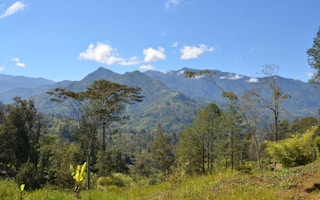Singapore’s much-anticipated list of approved international carbon credits will only accept REDD+ projects from Papua New Guinea if they consider deforestation across entire jurisdictions, as opposed to specific areas defined by individual project developers.
To continue reading, subscribe to Eco‑Business.
There's something for everyone. We offer a range of subscription plans.
- Access our stories and receive our Insights Weekly newsletter with the free EB Member plan.
- Unlock unlimited access to our content and archive with EB Circle.
- Publish your content with EB Premium.
REDD+ stands for “reducing emissions from deforestation and forest degradation”, with the plus referring to additional activities around conservation, sustainable forest management and carbon stocks.
The forest conservation mechanism has undergone a crisis of confidence in the past year on the back of multiple media exposés and academic papers calling into question the environmental benefits of the credits issued by the world’s largest certifier Verra through the Voluntary Carbon Standard (VCS).
In a joint press statement, the Ministry of Sustainability and the Environment (MSE) and the National Environment Agency (NEA) said that the carbon crediting programmes and methodologies included on Singapore’s eligibility list may differ for each host country, based on what is agreed upon by all parties under the respective implementation agreements.
To date, Singapore has substantively concluded negotiations for bilaterally-traded credits with Ghana, Vietnam, Paraguay and Bhutan. But Papua New Guinea is the sole host country that made the eligibility list, following the inking of Singapore’s inaugural Article 6 implementation agreement with the island state on the sidelines of COP28 in Dubai earlier this month.
Article 6 is a key part of the Paris Agreement that prevents double counting of emissions reductions by two countries engaged in carbon trading.
Carbon credits on Singapore’s whitelist can be used by large emitters to offset up to five per cent of their carbon tax obligations starting next year, where the carbon price will be revised to S$25 (US$19) per tonne of emissions – up from the current level of S$5 (US$4) per tonne. From 2026 onwards, tax-liable companies will have to pay S$45 (US$34) for each tonne of their carbon emissions.
NEA, the administrator of the city-state’s tax regime, said that the list will be reviewed annually “based on the latest science and evidence.” This could entail the addition or delisting of carbon crediting programmes and methodologies.
In October, the Singapore government released seven principles to guide its selection of approved overseas carbon credits. These principles include ensuring credits are not double-counted, represent additional emissions cuts, are real, have been quantified and verified, are permanent, cause no net harm, and do not cause emissions to increase elsewhere.
In addition to project-level REDD+ projects under VCS, the government has also excluded biochar projects using the VM0044 methodology, which quantifies carbon dioxide removals from the conversion of waste biomass into biochar at new biochar production facilities.
Apart from Verra’s VCS, the other carbon crediting programmes recognised by Singapore pertaining to Papua New Guinea projects are the Gold Standard for the Global Goals, American Carbon Registry and the Global Carbon Council.
All permitted methodologies will have to be active ones published before 31 March 2023.
A shift to the jurisdictional approach
To date, most REDD+ credits on the voluntary carbon markets are issued with reference to project-level baselines. Project-based forest offsets have been criticised for inflating their baselines through cherry-picking reference areas and failing to account for deforestation moving to areas outside the project, a risk more commonly known as leakage.
Singapore’s eligibility list with reference to host country Papua New Guinea explicitly excludes methodologies that fall under VCS’ “Sectoral Scope 14”, or the agriculture, forestry and other land uses category. These include the four most commonly used project-based REDD+ methodologies: VM0006, VM0007 VM0009 and VM0015.
The only exception is for REDD+ projects aligned with a juridictional baseline and programme, in accordance to Verra’s Jurisdictional and Nested REDD+ (JNR) framework. But only about 40 or so of Verra REDD+ projects that are currently registered or in the pipeline are situated within this framework – which is estimated to be less than half of the total REDD+ projects it has certified to date.
In a bid to restore confidence in forest carbon offsets, Verra is increasingly pivoting towards a jurisdictional approach.
Just last month, it unveiled its new “revolutionary” REDD+ methodology, which consolidates five existing methodologies (the four mentioned above as well as VM0037) and requires all baseline data for projects to be consistent within and across jurisdictions.
In response to Eco-Business’ queries, NEA said that Verra’s consolidated REDD+ methodology has yet to be assessed against Singapore’s eligibility criteria, but will be assessed as part of regular reviews of the eligibility list.
In its press release, Verra said that it will be engaging national governments to obtain this jurisdictional-level data, and expects it to be available for all existing REDD+ projects by the start of 2025. Though a specific timeline has not been given, Verra stated that all current avoided deforestation projects will be required to transition to its new methodology.
The creation of this new methodology will result in the deactivation of VM0009 – the first methodology ever written under the VCS standard by prominent REDD+ project developer Wildlife Works – as well as VM0037. Verra will also be updating VM0007, which will continue to be available under certain conditions for a limited time.
Further updates are expected to come for the other two methodologies, VM0006 and VM0015, by the first quarter of 2024.
Note [4 January 2024]: This article has been edited to include NEA’s response to media queries.










